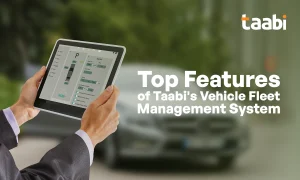Fuel costs play a crucial role in the success and profitability of logistics and fleet operations. As fuel prices continue to fluctuate and environmental concerns grow, companies are increasingly seeking ways to reduce their fuel expenses while maintaining efficient operations. This is where AI/ML-powered SaaS platforms come into play.
The innovative technologies offer a wealth of benefits for fuel cost optimization. By leveraging advanced algorithms, real-time data analysis, and predictive analytics, these platforms enable companies to make data-driven decisions, optimize routes, monitor vehicle performance, and implement fuel-saving strategies.
At Taabi we offer our customers AI/ML-powered SaaS platforms, with implementations to improve your fuel efficiency:
1. Real-time route optimization
2. Driver behavior monitoring
3. Predictive maintenance
4. Fuel consumption analytics
5. Optimal vehicle selection
In this blog, we will provide you with tips for reducing fuel consumption costs—tips that we have found relevant and significantly effective during our years of developing our platforms.
We hope that you as a reader can take away genuinely actionable insights for your fuel price problems!
Understanding how your operations impact your fuel cost
Fuel costs are a significant component of the overall operational expenses in the logistics industry. To effectively manage these costs, it is crucial to understand the factors that contribute to them. Three key factors influence fuel costs:
1. Vehicle efficiency
2. Fuel prices
3. Driving behavior
Vehicle efficiency plays a vital role in fuel consumption. Factors such as the type of vehicle, engine efficiency, aerodynamics, and maintenance impact how efficiently fuel is utilized. Investing in modern, fuel-efficient vehicles and implementing regular maintenance practices can help optimize fuel usage.
Fuel prices are another major factor. Fluctuating fuel prices can greatly impact a logistics company’s budget. Monitoring fuel prices, identifying cost-effective refueling locations, and negotiating bulk discounts are strategies to mitigate these expenses.
Driving behavior also influences fuel costs. Aggressive driving habits, excessive idling, and inefficient route planning can significantly increase fuel consumption. By promoting fuel-efficient driving techniques and providing training to drivers, companies can reduce fuel costs.
Fuel costs are of paramount importance in the overall operational expenses of a logistics company. They can account for a significant portion of the budget, impacting profitability and competitiveness. Effective management of fuel costs not only helps reduce expenses but also enhances sustainability efforts.
10 proven ways your company can save fuel costs
1. Speed Control:
One of the most effective ways to reduce fuel costs is by controlling your driving speed. Maintaining a moderate and steady speed can significantly improve fuel efficiency.
Speeding increases fuel consumption, mostly, as a result of tire rolling resistance and air resistance. Did you know that fuel mileage drops drastically when you drive above 80 km/h? Studies have estimated that if you drive for 8 kms over the speed of 80 km/h, yu incur a lose of Rs 7-10 per liter of fuel.
This can quickly add up to a substantial amount, especially for fleet operations covering long distances.
Scenarios on how speed control can impact fuel cost:
Scenario 1: Speeding on the Highway—Driving at high speeds on the highway increases air resistance, significantly reducing fuel efficiency. The increased drag force requires the engine to work harder, resulting in higher fuel consumption and increased fuel costs.
Scenario 2: Consistent Speed on City Roads—Maintaining a consistent speed on city roads, avoiding unnecessary acceleration and deceleration, improves fuel efficiency. By reducing the strain on the engine, fuel consumption decreases, resulting in lower fuel costs.
Solving the speed control challenge with AI/ML:
AI/ML-powered SaaS solutions can play a crucial role in promoting speed control. These platforms provide real-time speed monitoring, alerting drivers when they exceed set limits. Additionally, they analyze historical speed data to identify patterns and provide insights on optimal speeds for different road conditions, thereby improving overall fuel efficiency.
2. Idling Reduction:
Excessive idling can be a significant contributor to fuel waste. Naturally, encouraging drivers to reduce unnecessary idling will lead to substantial fuel savings.
Did you know that idling in most heavy-duty trucks consumes approximately 0.9 gallons of fuel per hour? While it may not seem significant, if you idle your truck for 20 minutes daily, it amounts to wasting 18 gallons of gasoline annually!
Scenarios on how idling reduction can impact fuel cost:
Scenario 1: Traffic Jams—In heavy traffic, idling for extended periods consumes fuel without moving the vehicle. By reducing idling time through strategies like turning off the engine, fuel consumption decreases, resulting in lower fuel costs.
Scenario 2: Delivery Services—In delivery services, frequent stops and idle time during loading/unloading can contribute to fuel wastage. Implementing practices such as minimizing engine idling and optimizing route planning reduces fuel consumption and lowers fuel costs.
Solving the idle time reduction challenge with AI/ML:
AI/ML-powered SaaS solutions offer idle reduction features that monitor and analyze idling behavior. These platforms provide insights into idle times, notify drivers when limits are exceeded, and help fleet managers track and manage idle time across their operations, ultimately improving fuel efficiency.
3. Load Optimization:
Optimizing the load of your vehicles is crucial for maximizing fuel efficiency. Balancing weight and ensuring proper load distribution can significantly impact fuel consumption.
Carrying excess weight can increase fuel consumption by up to 1-2% for every 100 pounds (45 kilograms) added. Additional rooftop cargo can reduce your fuel economy by 6%-17% on highways and up to 25% when driving at high speeds.
Scenarios on how load optimization can impact fuel cost:
Scenario 1: Proper Distribution of Cargo—Optimizing cargo distribution in a vehicle ensures even weight distribution, reducing strain on the engine and improving fuel efficiency. Proper load optimization leads to lower fuel consumption and reduced fuel costs.
Scenario 2: Removing Unnecessary Weight—Removing unnecessary weight from a vehicle, such as unused equipment or excessive cargo, reduces the load it carries. Lighter loads result in improved fuel efficiency, reducing fuel consumption and lowering overall fuel costs.
Solving the load optimization challenge with AI/ML:
AI/ML-powered SaaS solutions can provide valuable assistance in load optimization. These platforms leverage advanced algorithms and historical data analysis to suggest optimal load plans based on cargo specifications, vehicle capacities, and route requirements. By using these solutions, logistics companies can ensure efficient load distribution, minimize wasted space, and ultimately reduce fuel consumption.
4. Aerodynamics Improvement:
Enhancing the aerodynamics of your fleet vehicles can have a significant impact on fuel efficiency. By reducing drag and improving airflow, you can decrease fuel consumption and save on costs.
Studies have shown that even a single aerodynamic improvement to your vehicle’s design can reduce drag and reduce your fuel consumption by 0.042 — 0.12 Km per liter. The fuel consumption further reduces if you make multiple aerodynamic adjustments; a 10% reduction in aerodynamic drag can improve your fuel efficiency by 5%.
Although this might seem like an insignificant improvement it can generate visible cost savings when traversing long distances via highways at a constant speed. Needless to say, this tiny bit of saving, per trip, adds up over a year to increase your annual profit margin.
Scenarios on how aerodynamics improvement can impact fuel cost:
Scenario 1: Tires and Wheel Covers—Using low rolling resistance tires and wheel covers minimizes turbulence and drag. Reduced resistance enhances fuel efficiency by requiring less energy to overcome friction, leading to decreased fuel consumption and lower fuel costs.
Scenario 2: Tarping or Covering Loads—Covering loads with tarps or using streamlined cargo containers reduces air drag. By minimizing the impact of wind resistance, aerodynamic improvements contribute to better fuel efficiency and reduced fuel costs during transportation.
Solving the aerodynamics improvement challenge with AI/ML:
AI/ML-powered SaaS solutions can assess vehicle data, including shape, dimensions, and historical performance, to suggest specific aerodynamic improvements. These platforms provide insights into which enhancements are most effective for each vehicle type, facilitating informed decision-making and maximizing fuel efficiency.
5. Real-time Traffic Updates:
Staying updated with real-time traffic information can help drivers avoid congested routes, reduce idle time, and optimize fuel consumption.
Some studies have shown that traffic congestion that increases the traveling time to 4x can increase fuel consumption to 2x. Whereas, some other studies have found, that fuel consumption is generally 20% – 45% higher during the rush hours.
Scenarios on how real-time traffic updates can impact fuel cost:
Scenario 1: Congestion Avoidance—Real-time traffic updates help drivers avoid congested routes, reducing the time spent in traffic jams. By avoiding stop-and-go traffic, fuel consumption decreases, leading to lower fuel costs.
Scenario 2: Dynamic Speed Adjustments—Real-time traffic updates allow drivers to adjust their speed based on current traffic conditions. Slowing down when approaching congested areas reduces the need for sudden braking and acceleration, improving fuel efficiency and reducing fuel costs.
Solving the real-time traffic visibility challenge with AI/ML:
AI/ML-powered SaaS solutions utilize advanced algorithms to analyze real-time traffic data and provide optimized route suggestions. These platforms can factor in traffic congestion, road incidents, and historical traffic patterns to help drivers choose the most fuel-efficient routes in real time, saving both time and fuel.
6. Optimal Refueling Practices:
Implementing optimal refueling practices is an effective way to reduce fuel costs. Companies can save significantly on fuel expenses by strategically planning refueling and taking advantage of competitive fuel prices.
Did you know that fuel prices can vary by up to 20% within a single city? By identifying the most cost-effective refueling locations and timing, companies can achieve substantial savings in their overall fuel costs.
Scenarios on how optimal refueling practices can impact fuel cost:
Scenario 1: Timing Refueling with Low Fuel Prices—Monitoring fuel price trends and refueling when prices are lower can result in significant savings on fuel costs, as prices fluctuate throughout the week or month.
Scenario 2: Efficient Refueling Frequency—Avoiding unnecessary refueling and filling up when the tank is closer to empty maximizes fuel usage. Frequent, smaller refueling trips can add up to higher costs over time.
Solving the refueling practice optimization challenge with AI/ML:
AI/ML-powered SaaS solutions can monitor real-time fuel prices, analyze historical data, and recommend optimal refueling practices. By leveraging these platforms, logistics companies can track fuel prices, identify the most cost-effective locations, and negotiate better fuel prices, resulting in substantial fuel cost savings.
7. Optimize Delivery Schedules:
Optimizing delivery schedules can have a significant impact on fuel costs. By streamlining routes, minimizing empty or low-load trips, and maximizing resource utilization, companies can reduce fuel consumption and improve efficiency.
Did you know that optimizing delivery schedules can result in fuel savings of up to 15%? By strategically planning routes and consolidating deliveries, companies can minimize fuel waste and increase operational productivity.
Scenarios on how optimized delivery schedules can impact fuel cost:
Scenario 1: Consolidated Deliveries—Consolidating multiple deliveries into a single trip reduces the number of vehicles on the road, leading to fuel savings. Efficiently planning and grouping deliveries help optimize fuel usage and lower fuel costs.
Scenario 2: Off-Peak Deliveries—Scheduling deliveries during off-peak hours can help avoid heavy traffic congestion. By minimizing idle time and reducing time spent in traffic, fuel consumption decreases, resulting in lower fuel costs.
Solving the delivery schedule optimization challenge with AI/ML:
AI/ML-powered SaaS solutions leverage advanced algorithms to analyze data and recommend optimal delivery schedules. These platforms consider various factors, such as traffic conditions, customer preferences, and vehicle capacities, to help companies streamline routes, minimize fuel consumption, and enhance overall operational efficiency.
8. Geofencing-based Vehicle Tracking:
Implementing geofencing-based vehicle tracking systems can lead to significant fuel savings. By defining virtual boundaries and receiving real-time alerts, companies can monitor and enforce fuel-efficient behaviors, ultimately reducing fuel costs.
Studies have shown that implementing geofencing technology can lead to a 5-10% reduction in fuel consumption. By proactively monitoring vehicle movements and promoting fuel-efficient driving behaviors, companies can achieve notable cost savings.
Scenarios on how geofencing-based vehicle tracking can impact fuel cost:
Scenario 1: Unauthorized Use Detection—Geofencing helps detect unauthorized vehicle use or deviations from designated routes. Promptly addressing such incidents minimizes unnecessary mileage, conserves fuel, and lowers fuel costs.
Scenario 2: Maintenance and Fueling Reminders—Geofencing-based vehicle tracking can send reminders for scheduled maintenance and refueling. Proper vehicle maintenance ensures optimal fuel efficiency, reducing fuel consumption and associated costs.
Solving the vehicle tracking challenge with AI/ML:
AI/ML-powered SaaS solutions play a crucial role in geofencing-based vehicle tracking. The AI/ML platforms use machine learning algorithms to analyze real-time location data, identify deviations from optimized routes, and provide actionable insights to drivers and fleet managers. By leveraging these solutions, companies can proactively enforce fuel-efficient driving behaviors, optimize routes, and achieve significant fuel cost savings.
9. Monitor Tire Pressure:
Regularly monitoring and maintaining proper tire pressure can significantly impact fuel efficiency. Underinflated tires increase rolling resistance, leading to decreased fuel economy. By ensuring optimal tire pressure, companies can save on fuel costs.
The U.S. Department of Energy states that for every 1 psi (pound per square inch) drop in tire pressure, fuel efficiency decreases by approximately 0.4%. By keeping tires properly inflated, companies can achieve noticeable fuel savings.
Scenarios on how tire pressure monitoring can impact fuel cost:
Scenario 1: Optimal Tire Inflation—Regular tire pressure monitoring ensures tires are properly inflated. Maintaining optimal tire pressure reduces rolling resistance, improves fuel efficiency, and lowers fuel consumption, resulting in cost savings.
Scenario 2: Underinflated Tyre Alerts—Tire pressure monitoring systems can provide alerts for underinflated tires during driving. Promptly addressing low tire pressure helps maintain fuel-efficient driving conditions, reducing fuel consumption and associated costs.
Solving the tire pressure monitoring challenge with AI/ML:
AI/ML-powered SaaS solutions can integrate with tire pressure monitoring systems and vehicle sensors to collect real-time tire pressure data. The platforms can analyze tire pressure patterns, provide proactive alerts to drivers and fleet managers, and offer insights on optimal tire pressure levels for different vehicles and conditions. By leveraging these solutions, companies can ensure optimal tire performance, maximize fuel efficiency, and reduce fuel costs.
10. Driver Performance Monitoring:
Monitoring driver performance can significantly impact fuel costs. By tracking and evaluating driver behavior, companies can identify areas for improvement, promote fuel-efficient driving techniques, and achieve notable fuel savings.
Studies have shown that aggressive driving (including speeding, rapid acceleration, and braking) can lower your mileage by 15% – 30%. By monitoring and improving driver performance, companies can achieve substantial reductions in fuel costs.
Scenarios on how driver performance monitoring can impact fuel cost:
Scenario 1: Speeding and Aggressive Driving—Monitoring driver behavior helps identify instances of speeding and aggressive driving. By addressing these behaviors, fuel efficiency improves, leading to reduced fuel consumption and lower fuel costs.
Scenario 2: Optimal Acceleration and Braking—Driver performance monitoring helps identify inefficient acceleration and braking patterns. Encouraging smooth and gradual acceleration and braking reduces fuel wastage, resulting in improved fuel economy and cost savings.
Solving the driver performance monitoring challenge with AI/ML:
AI/ML-powered SaaS solutions utilize advanced algorithms to analyze driver performance data and provide actionable insights. These platforms can identify inefficient driving behaviors, offer real-time feedback to drivers, and deliver personalized coaching programs to promote fuel-efficient practices. By leveraging these solutions, companies can improve driver performance, optimize fuel consumption, and reduce overall fuel costs.
Conclusion:
Efficiently managing fuel costs is a key priority for logistics and fleet operations. By implementing the various strategies and tips discussed in this blog, companies can significantly reduce their fuel expenses and improve their overall operational efficiency.
However, to truly revolutionize fuel cost management, businesses can benefit from leveraging AI/ML-powered SaaS platforms that are specifically designed for logistics and fleet operations.
At Taabi we design & develop SaaS platforms that offer a wide array of features, including real-time data analysis, predictive analytics, route optimization, driver performance monitoring, digital locking, fuel price tracking, and much more!
By harnessing the power of our advanced algorithms and machine learning, you can make data-driven decisions, optimize fuel consumption, and ultimately enhance your bottom line.
When it comes to logistics and fleet operations management, investing in AI/ML-powered SaaS platforms is a game-changer! You can not only streamline fuel cost management but also get comprehensive solutions for fleet tracking, maintenance, scheduling, and customer satisfaction. Integrate powerful AI/ML tools into your operations to unlock significant cost savings, improve operational efficiency, and gain a competitive advantage in the market.







